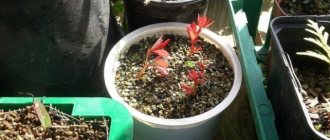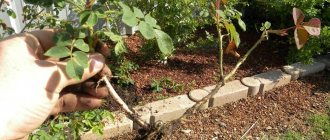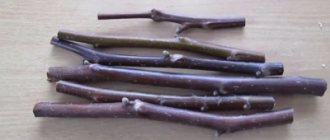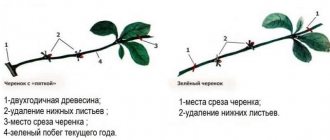Monstera is called an evergreen exotic plant. Under natural conditions, it lives in South and Central America, in the humid areas of Brazil and Asia. This large flower from the Araceae genus has large and curly stems; huge carved leaves can reach a size of up to 60 cm. In the wild, the plant is attached by its roots to various supports and trees. At home it is grown as a potted indoor flower and generally does not bloom. This article talks about how monstera reproduces, the advantages and disadvantages of this or that method, and also why the plant can die at home.
Monstera: propagation at home
This flower has a huge number of beneficial properties:
- constantly releases oxygen during daylight hours;
- maintains a humid climate in the house due to liquid evaporating from the surface of large sheets;
- reduces the harm of electromagnetic waves from household appliances;
Flower in nature
- absorbs chemicals from the air that are released from furniture (varnish, dyes);
- ionizes indoor air;
- has an excellent energy field that has a good effect on the human body: it calms, saves from indecision;
- has a beneficial effect on the entire body: strengthens the immune system, increases brain activity.
Reproduction of monstera at home will be possible only when all the necessary instructions are followed. First, it is recommended to prepare the soil for the plant. At the bottom of the pot you must put a layer of broken bricks or shells and only after that add a mixture of humus and peat, as well as a 4 cm piece of river sand.
Note! The cuttings can be planted immediately in the sand, but as soon as the first roots form they need to be transplanted into the soil. The air temperature for favorable maintenance of seedlings or crops should be no higher than 25°C.
Monstera loves sunlight very much, because of this you need to carefully choose the place for its location. It should be very light, but without direct sunlight. If the location is chosen incorrectly, the rooting process will be very slow.
How to effectively propagate Monstera at home? To do this, you need to create high humidity, this will be the secret of success. Young seedlings need daily spraying with water at room temperature: early in the morning and after sunset. The correct choice of fertilizing will also have a beneficial effect on the rooting of the plant at home.
Possible problems, tips
To grow a monstera at home, you need to remember that it is best to take cuttings or plant shoots in the spring. It is worth paying special attention to the quality and nutritional value of the soil, the size of the pot, the degree of illumination and the regularity of watering. If these requirements are ignored, the flower will grow slowly, the leaves will become crushed and wither, and the vine will not have a beautiful appearance.
To avoid problems when growing, you should follow the recommendations of experienced gardeners given below.
- In a plant propagated by cuttings, the stem grows only upward, but does not increase in width. So that the trunk at the base does not break as it grows, it must be sprinkled with earth, periodically replanted in a deeper pot, strengthened with a support, a support in the form of a ladder.
- Yellowing and falling of withered leaves usually indicates a too dry and hot microclimate in the apartment, lack of watering and fertilizing.
- After watering and before rains, the monstera “cries”. Drops of water flow down from the edges of its sheets. Because of this feature, the vine is often called “weeping”. There is no need to worry about this; this is a natural process for a tropical flower.
- If at the end of autumn the leaves die and fall off, you need to move the pot away from radiators and heaters, humidify the air in the room and around the flower more often, and spray the foliage daily.
- Sometimes the leaves become translucent in appearance in summer and lose their bright color. This occurs due to an excess of lighting when the plant is exposed to direct sunlight. To correct the error, you should move the pot deeper into the room and remove it from the windowsill.
Rarely, the plant is affected by insect pests such as spider mites, aphids or scale insects. To combat them, you need to use special preparations, insecticides, spray the leaves with water more often, and follow the care conditions.
Below in the video you can study in detail how to propagate indoor monstera, watch a clear master class with tips from an experienced gardener.
How to propagate Monstera from cuttings
Monstera - home care, transplantation and reproduction
How to propagate a monstera flower by apical cuttings? The top of a ripe flower is cut off and placed in water so that the shoot begins to sprout roots. For this, only two healthy cuttings are enough. However, if the goal is the rapid appearance of the first marsh leaves, then you need to be patient until an even larger number of roots are formed.
Monstera roots
Propagation by stem cuttings
Another popular option for plant propagation is to use stem shoots as planting material. The stems need to be selected so that they have several large buds. This cut part is applied to the soil with the bud down. There is no need to cover it with soil on top.
An important rule for care is only constant watering and spraying of the outermost layer of soil. To maintain a certain microclimate near the landing site, it is recommended to cover it with a protective film. This will allow the plant to quickly take root and take root. We must not forget to ventilate from time to time by lifting the film. After the first roots grow, the cutting must be transplanted to a permanent habitat. The appearance of the first leaves will not take long; they are usually heart-shaped. Then they slowly turn into large carved leaves.
How to take monstera cuttings
There are several methods for propagating monstera.
Note! Cuttings are the most popular and easiest of them. Cuttings must be taken from the middle or upper part of the plant, but the shoot must have at least one bud.
Some rules for cutting a plant:
- treat the soil with a medicine that stimulates the formation and growth of roots;
- place the shoots in an opaque container with one-third of the water settled for three days;
- the water should be at room temperature, you can add a little new water;
- When two or three new roots appear, they can be safely planted in a pot.
The following substrate mixture is well suited for planting plants (all components are taken in equal parts):
- turf;
- peat;
- river sand;
- humus.
How to take a shoot from a monstera
To propagate a plant with your own hands, you can take any part of the flower:
- stem cuttings are a simple and practical method that bears fruit very quickly;
- apical cuttings are an easy option and generally always lead to success;
- leaves - are not used so often because they cannot always take root;
- aerial roots are quite difficult, but the most reliable and reliable method of propagation;
- seeds are a long and difficult process. Mainly used to breed new plant species.
Rooting in water
Important! The shoots must be cut off carefully; in no case should you pick up and tear off the leaves or tops, this applies to all species. When taking a shoot, the tools (scissors) must be disinfected, otherwise there is a very high risk of the plant developing chlorosis (the leaves turn yellow and soon fall off).
Daily care rules
Monstera needs feeding from April to August. Fertilizers are applied every 7–10 days. Experienced plant growers fertilize Monstera with a purchased mixture suitable for all types of decorative deciduous plants.
Note! If the vine has grown too quickly, its growth can be slowed down by increasing the interval between feedings. As the root system matures, it expands and some roots break through to the surface.
The plant grower’s task is to notice such attacks in time and direct the roots deeper into the pot
As it matures, the root system grows and some roots break through to the surface. The plant grower’s task is to notice such attacks in time and direct the roots deeper into the pot.
Monstera should be watered sparingly, regardless of the time of year. Water the vine with settled warm water. In summer, water treatments in the form of sprays and warm showers are desirable. This is especially true for Monstera gracefu. In winter, flower growers wipe the vine leaves with slightly warmed water.
Important! With insufficient lighting, monstera leaves become smaller over time and become less dissected. Monstera - a smart vine
She constantly communicates with her owner, giving peculiar signals. If the grower can decipher these hints, he will be able to grow a monstera as majestic as it can be found in the wild.
Monstera is a smart vine. She constantly communicates with her owner, giving peculiar signals. If the grower can decipher these hints, he will be able to grow a monstera as majestic as it can be found in the wild.
This is how the monstera signals:
- the appearance of dark brown dry spots on the leaves is a clear sign that the monstera is suffering from dry air;
- wet dark spots are the consequences of overzealous watering, which does not benefit the vine;
- yellowing foliage is a signal that there is too much moisture.
Aerial roots
With age, the vine loses its attractiveness, the lower foliage falls off, exposing the trunk. In order for it to grow again, at the beginning of spring the upper part of the stem is cut off by about 30 cm so that there are 2-3 leaves in the cut area. Thanks to this manipulation, the lower part receives an additional portion of minerals, and the branches grow back.
The cut top can be germinated in warm water and then transplanted into a separate container. First, aerial roots are formed, and then the development of the lower root system begins. To propagate the vine, it is enough to separate the top leaves, germinate them and plant them in different pots.
For your information! By systematically pruning the top of the monstera out of a desire to prevent its further growth, the grower must be prepared for the fact that the vine will still increase in size, only in width.
A plant grower who has set the goal of growing a beautiful monstera should not forget about the parasitic tendencies of this species. The pot with the plant itself and the adjacent areas of the home must be systematically inspected to prevent damage to property. If the monstera senses that there is additional support nearby, for example, a piece of peeling wallpaper or some piece of furniture, it will definitely cling to the nearest ledge and continue development.
That's all! Those who want to grow this flower should re-read the article again to know what to prepare for and what to stock up on. Only then can you go to the flower shop to pick up the “monster”.
Propagation by aerial roots
Monstera variegated or variegated in the interior
This means propagation of the flower by shoots with aerial roots. To tell the truth, this method, performed independently, requires some effort. But in comparison with the methods described above, here we can say with an absolute guarantee that reproduction will be successful. To do this, you need to find a shoot with the largest aerial roots and create high humidity for them. To achieve this, you can wrap the roots in moss, which must be watered or sprayed every day. To prevent the moss from drying out, it is advisable to wrap it loosely to the trunk using regular film. This will not prevent the roots from growing quickly.
Simply put, you can propagate a plant yourself using aerial roots without cutting them. During cultivation, the shoot can even grow several leaves. When the roots become stronger, you need to make a cut on the stem and remove the cutting, and then plant it in a permanent habitat.
Description
Indoor plants in the house! https://www.youtube.com/watch?v=zZ6IXJeORKc How they decorate our home, office Monstera is a beautiful vine that grows wild in humid tropical and equatorial zones. Monstera belongs to the Araceae family. . Monstera has many aerial horses, allowing it to easily hold on to supports and other large plants. #Monstera is a luxurious plant and you can find out how it can be propagated in the film. Monstera propagation by cuttings. #Rooting monstera cuttings. Video blogger #EkaterinaSnytko, The composition “Disco Lounge” belongs to the performer Kevin MacLeod. License: Creative Commons Attribution (https://creativecommons.org/licenses/by/4.0/). Original version: https://incompetech.com/music/royalty-free/index.html?isrc=USUAN1100602. Artist: https://incompetech.com/
I thank the author for the material provided https://www.youtube.com/watch?v=sv0jq9UcUqo Music by Lydia Kirillova https://www.deezer.com/album/46725722?utm_source=deezer&utm_content=album-46725722&utm_term=1698304442_1507689573&utm_medium=web Thank you author's for wonderful music. Music in video with permission of the author! ______________________ The composition “Falling Leaves” belongs to the performer Lydia Kirillova. License: Creative Commons Attribution (https://www.deezer.com/album/46725722?utm_source=deezer&utm_content=album-46725722&utm_term=1698304442_1507689573&utm_medium=web ). Performer: https://www.youtube.com/channel/UCa2ebBhjAZp5BhqmzmpRG4w ___________ Channel about indoor plants. About fertilizing, disease control, Preparation for transplantation and preparation of earthen mixture. The channel is aimed at helping beginners work with indoor plants. A lot of information can be found on my website https://sovetecaterinas.ru/category/rasteniya. My email address _ I invite you to social networks: Facebook https://www.facebook.com/ekaterinasnitco In contact https://vk.com/snitcoecaterina Twitter Tweets by SnitcoEcaterina Odnoklassniki https://ok.ru/ecaterinasnitco ___ You can contact Skype for questions about indoor flowers. Skype address ecaterinasnitco1 Make money doing what you love! Subscribe to the affiliate program https://www.scalelab.com/apply/dkonovalov?referral=48200 Create videos and earn money!! https://www.youtube.com/channel/UCwFttAYyo2y8mbBPNYHsKjQ
Propagation by leaves
Botanists consider the propagation option using foliage to be less practical and effective. It is mainly used when a leaf accidentally breaks. In this case, it is placed with its petiole in water and the roots are expected to emerge. In order for the leaf to take root in the ground and a full-fledged monstera to grow from it, you will need to grow a lot of roots. For rooting in water, it is advisable to choose a larger container.
Phalaenopsis propagation at home: examples by children and cuttings
Like other methods, propagation by petal has its disadvantages:
- roots grow slowly. To get a solid root system, you need to wait at least a month;
- the leaf may dry out before roots begin to appear.
Note! The roots of the flower do not tolerate sunlight, so the dishes should be opaque. After the roots grow, they are transplanted into the ground. Its composition is identical to that used in other dilution methods.
How to root a monstera
Another type of cuttings is rooting in the soil. To understand how to root monstera in the soil, you need to follow step-by-step steps:
- First you need to prepare the soil composition, dilute the sandy or peat substrate. Pour it into a container;
- The suitable soil temperature for the shoot to take root is about 26°C and even higher. Humidity - high;
- to create tropical conditions for monstera for easier growth, the pot needs to be covered with cling film;
- in about three weeks the shoot will sprout its first roots, there will be quite a lot of them. The larger the root system of the flower, the better it will take root;
- transplant the shoot into a pot with soil.
Important! The disadvantage of this propagation method is that as it grows, the stem strengthens and grows, but not at the base. There it will look the same as when planting the plant. Therefore, a young monstera can easily break.
In such a situation, there are two options for solving the problem. They can be used either separately or in combination:
- take initially thick shoots;
- make a support for the plant.
Another method of rooting a branch in the soil is horizontal. You need to cut off a stem shoot with at least three buds and place it on the ground. The composition should be light, for example, sphagnum and river sand. The branch does not need to be covered with soil; it is important that one bud lies on the soil. Besides:
- regular watering and spraying of the shoot is needed;
- cover the container with film;
- after the first root shoots and petals are formed, the cutting is transplanted to a permanent location.











